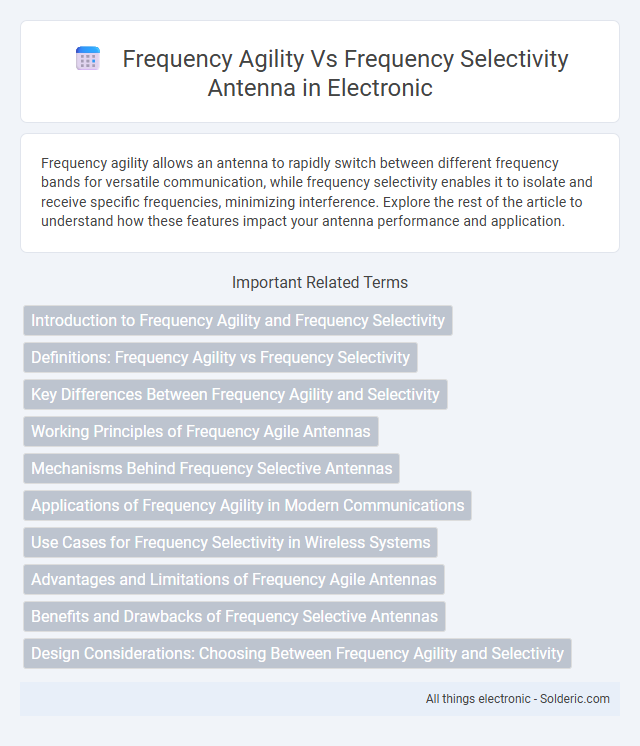Frequency agility allows an antenna to rapidly switch between different frequency bands for versatile communication, while frequency selectivity enables it to isolate and receive specific frequencies, minimizing interference. Explore the rest of the article to understand how these features impact your antenna performance and application.
Comparison Table
| Feature | Frequency Agility Antenna | Frequency Selectivity Antenna |
|---|---|---|
| Definition | Capable of changing operating frequency dynamically over a broad spectrum. | Designed to operate efficiently at a specific frequency or narrow frequency band. |
| Frequency Range | Wideband or multiple bands with rapid switching. | Narrowband, focused frequency range. |
| Use Cases | Communications requiring frequency hopping, spread spectrum, cognitive radio. | Applications needing interference rejection and precise tuning. |
| Tuning Mechanism | Electronic tuning via varactors, MEMS switches, or RF switching components. | Passive design elements like resonators and filters fixed at target frequency. |
| Advantages | Flexibility, frequency diversity, improved interference avoidance. | High selectivity, strong rejection of out-of-band signals, stable performance. |
| Disadvantages | Complex control circuitry, higher cost, potential tuning latency. | Limited bandwidth, less adaptable to frequency changes. |
| Typical Technologies | Reconfigurable antennas, software-defined radio antenna systems. | Bandpass antennas, cavity filters, resonant structures. |
Introduction to Frequency Agility and Frequency Selectivity
Frequency agility refers to an antenna's ability to quickly switch between different frequency channels, enhancing communication reliability and security, especially in dynamic environments. Frequency selectivity defines an antenna's capacity to isolate and respond to a specific frequency band while minimizing interference from adjacent signals, crucial for clear signal reception. Understanding these concepts helps optimize your antenna system for either adaptable frequency hopping or precise frequency targeting depending on your communication needs.
Definitions: Frequency Agility vs Frequency Selectivity
Frequency agility refers to an antenna's ability to rapidly switch between different frequency bands, enhancing its versatility in dynamic communication environments. Frequency selectivity, on the other hand, defines an antenna's capability to isolate and operate effectively within a specific frequency range, minimizing interference from unwanted signals. Understanding these distinctions helps you choose the right antenna for applications requiring either broad spectrum flexibility or precise frequency targeting.
Key Differences Between Frequency Agility and Selectivity
Frequency agility allows an antenna to rapidly switch between multiple frequency bands, enhancing its adaptability to different communication channels. Frequency selectivity refers to an antenna's ability to isolate and receive signals within a narrow frequency range, improving signal clarity and reducing interference. Your choice depends on whether dynamic frequency hopping or precise signal filtering better suits your communication needs.
Working Principles of Frequency Agile Antennas
Frequency agile antennas operate by dynamically tuning their resonant frequency through components like varactor diodes or MEMS switches, enabling rapid adaptation to changing signal environments. This tuning mechanism adjusts the antenna's impedance and radiation characteristics, allowing efficient transmission and reception across multiple frequency bands without physical modification. The agile control of frequency reduces interference and enhances communication reliability in dynamic spectrum environments.
Mechanisms Behind Frequency Selective Antennas
Frequency selective antennas employ resonant structures or metamaterials to achieve frequency agility, enabling them to dynamically adjust their frequency response for targeted bands. These antennas utilize mechanisms such as tunable varactors, microelectromechanical systems (MEMS), or phase-change materials that alter the antenna's electrical length or impedance, thus enhancing frequency selectivity. The controlled resonance and impedance matching enable precise filtering and reconfiguration, which optimizes performance across multiple frequency bands without sacrificing antenna efficiency.
Applications of Frequency Agility in Modern Communications
Frequency agility enhances modern communication systems by enabling antennas to rapidly switch between multiple frequency bands, improving signal resilience and reducing interference in dynamic environments such as military communications and cognitive radio networks. This adaptability supports secure, anti-jamming operations and maximizes spectrum efficiency by allowing your devices to access underutilized frequencies in real-time. Compared to frequency selective antennas, frequency agile antennas provide superior flexibility for applications requiring frequent channel hopping and dynamic spectrum management.
Use Cases for Frequency Selectivity in Wireless Systems
Frequency selectivity in antennas allows wireless systems to isolate specific frequency bands, enhancing signal quality and reducing interference in congested environments. This attribute is crucial for applications like cognitive radio, spectrum sensing, and secure communications where precise frequency discrimination optimizes performance. Frequency agile antennas, by comparison, rapidly switch frequencies but rely on selectivity for targeted signal processing in multi-band and dynamic spectrum access scenarios.
Advantages and Limitations of Frequency Agile Antennas
Frequency agile antennas offer the advantage of rapidly switching between multiple frequency bands, enhancing communication flexibility and resistance to jamming or interference. Their dynamic frequency tuning supports diverse applications such as cognitive radio, electronic warfare, and multi-band sensing, enabling real-time adaptation to changing spectral environments. However, limitations include increased design complexity, potential compromises in antenna efficiency and gain across wide frequency ranges, and higher implementation costs compared to frequency selective antennas.
Benefits and Drawbacks of Frequency Selective Antennas
Frequency selective antennas offer precise targeting of specific frequency bands, enhancing signal clarity and reducing interference in crowded spectral environments. Their benefits include improved signal-to-noise ratio and the ability to operate efficiently in multi-band systems without requiring complex filtering circuits. However, these antennas may suffer from limited bandwidth flexibility and increased design complexity, potentially restricting Your device's adaptability to dynamic frequency changes.
Design Considerations: Choosing Between Frequency Agility and Selectivity
Design considerations for antennas require evaluating frequency agility and frequency selectivity based on application needs. Frequency agile antennas offer broad operational bandwidth and rapid frequency switching, making them ideal for environments with dynamic spectrum usage or multiband communication systems. Your selection should balance these advantages against the precise filtering and interference rejection capabilities of frequency selective antennas, which enhance signal clarity in static frequency environments.
frequency agility vs frequency selectivity antenna Infographic

 solderic.com
solderic.com